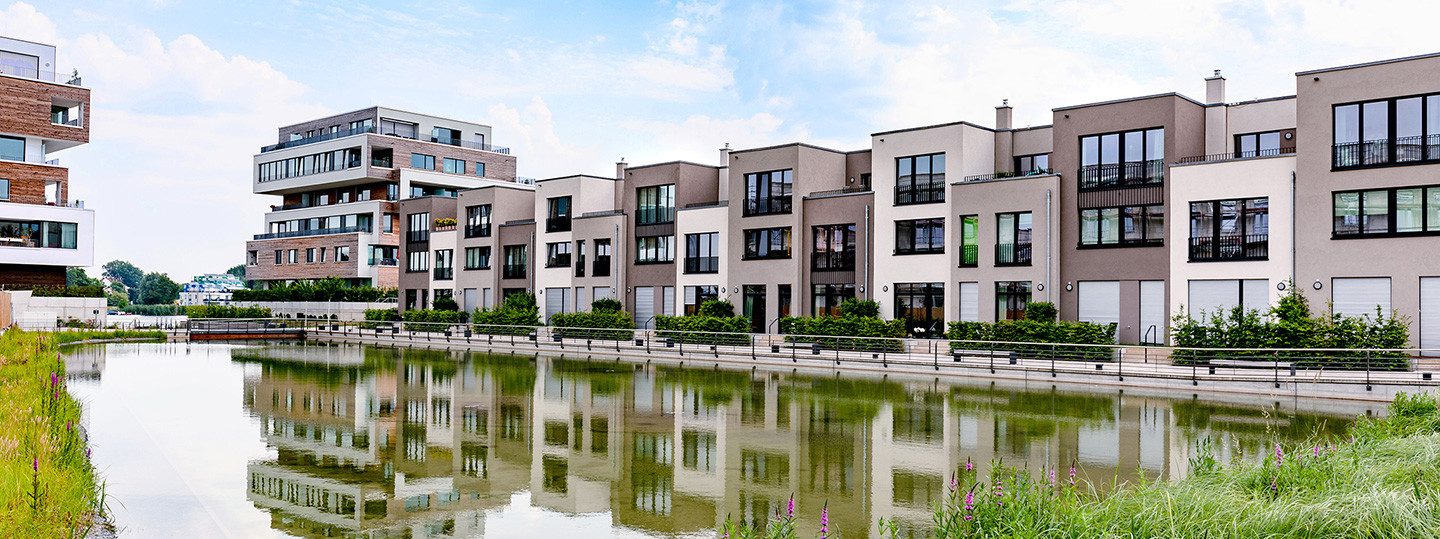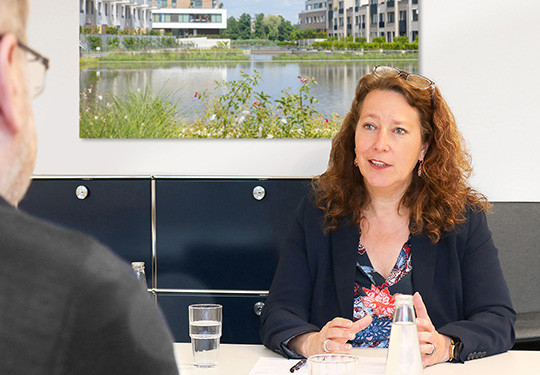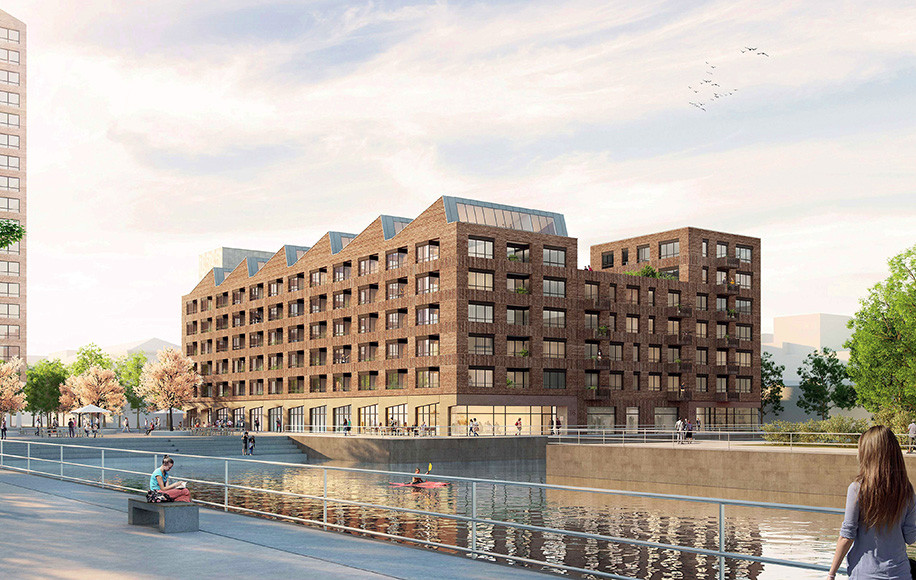
Sustainable district development: How we create ecologically, economically and socially sustainable living space
An interview on sustainable district development with Eva Weiß, Managing Director of BUWOG
Mrs Weiß, you are responsible for a new construction project pipeline of around 32,000 flats in Germany. What developments and trends do you see?
Today more than ever, the real estate sector faces the important task of implementing future-proof solutions for many social megatrends: Sustainability, demographic change and changing lifestyles and working environments are just some of these topics. The questions are manifold: How is it possible to create ecologically sustainable living space while making optimal use of the resource land? How can smart technologies and innovative construction methods be used not only to build sustainable properties, but also to supply and operate them in an economically efficient and energy-saving way in the long term? How can urban density be achieved, a socially mixed city of short distances that offers more quality of life despite limited space?
Sustainable district development offers the opportunity to answer these questions in a forward-looking way, which can be experienced in an impressive way when a former industrial conversion area is transformed into a new place worth living in. We think in terms of holistic neighbourhoods: We create the structural and conceptual conditions for good neighbourhoods to develop in our quarters and for people to feel comfortable, for innovative energy concepts or e-mobility offers and much more. To sum up: We make sure that our motto is put into practice - live happily.
Do you also see a change in housing? What will flats look like in the future?
Minimalism will remain a trend, but not as a renunciation, but according to the motto: great function in a small space! Young people in particular like to live light, they share, stream or lease instead of own. But the same applies to older people: Functional floor plans and barrier-free access - also to common areas where people meet each other - all this is becoming more important than pure living space.
At the same time, the relevance of the living environment is increasing. Thus, in our district developments, we also consistently integrate social aspects such as meeting points, neighbourhood cafés, outdoor areas with recreational qualities, pocket parks, promenades, play areas and other places of encounter and exchange. Living does not end at the flat door!

Our interviewee
Eva Weiß is the Managing Director of BUWOG Bauträger GmbH and, together with Thomas Bestgen, managing director of UTB Projektmanagement GmbH, heads the business of the planning consortium Das Neue Gartenfeld. This unites the developers UTB Projektmanagement GmbH, BUWOG, Baugenossenschaft BeGeno16 eG, Wohnungsbaugenossenschaft Am Ostseeplatz eG and Jula GmbH. Eva Weiß is also a member of the regional board of ZIA Zentraler Immobilien Ausschuss e.V. as well as a member of the board of BfW Bund Freier Wohnungsunternehmen Berlin-Brandenburg and an elected member of the IHK general assembly.
What is your forecast for Berlin?
In concrete terms for Berlin, the demand for housing will continue to rise, because the capital continues to experience a lot of immigration. With large new building quarters - for example with the Halske Sonnengärten on Saatwinkler Damm with around 1,000 flats or also with the development of Gartenfeld Island with around 3,700 flats - we are making a contribution to ensuring that Berlin's goals for the creation of new living space can be achieved. The last large contiguous areas tend to be outside the S-Bahn ring. There, in the outskirts, the residential locations will continue to gain in attractiveness through district developments such as those by BUWOG. At the same time, this requires better transport connections to the outer areas and the communities around Berlin.
We are currently seeing a sharp rise in energy prices, and materials and craftsmen are also scarce. How do you perceive this in your projects?
In our projects under construction, we don't see any effects yet. But of course we notice that suppliers are more cautious about fixed prices, supply chain problems are also making themselves felt. Steel, which we need for the shell construction, is particularly affected. We are trying to absorb the price increases with a good construction cost reserve. And we are watching the development of material prices very closely and intervene if there are problems.
Speaking of costs - is sustainable district development still an issue under the new framework conditions?
Absolutely! Sure, ESG taxonomy costs money, but it is also an investment in the future. We have to deal with ESG criteria and renewable energies. Sustainability is a strategic orientation of the entire group and is the basis for all projects. This includes internal benchmarks on various criteria, for example the primary energy factor, the proportion of parking spaces equipped with electric mobility, sharing models in large neighbourhoods, social criteria such as senior-friendly living. But the sponge city model with large rainwater retention basins is also part of the catalogue.
What is important to me above all is that investing in sustainability is a good investment - in the future, in climate resilience and in living space that is not only ecologically good, but also economically good to manage over the long life of real estate! Ecology, economy and social sustainability are a triad for us.
BUWOG is currently implementing a model project of the future with partners, "Das Neue Gartenfeld" in Berlin-Spandau. How should one imagine the planning here?
As a planning community, we already established a manifesto with the guidelines for an innovative and future-proof supply infrastructure in the preliminary planning phase in 2018 and formulated a common goal: To develop a demand-oriented, low-emission and mobility-strong urban quarter. The urban space should benefit people, not motorised individual traffic. For this reason, parking areas are consistently planned at the edge of the settlement. Due to its synergetic approach, sustainable energy supply and digitalisation, "Das Neue Gartenfeld" will be ten years ahead of the climate targets set by the German government for 2040. The "neighbourhood app" to be developed by the "Quartierswerk" will play an important role in this. It will be more than just a gimmick on a mobile phone.
How would you describe the function of this neighbourhood app?
If the "Quartierswerk" is the energetic and infrastructural backbone for "Das Neue Gartenfeld", the Quartiers-App is the brain. It combines functionality with service: from sharing offers to delivery services, from facility and billing services to residential services for older people or those with special needs. In order to realise the model neighbourhood, a wide variety of actors - both private and cooperative real estate companies - have come together to form a joint planning community. Because one thing is clear: many infrastructure issues that need to be dealt with - from traffic to energy supply - need to be coordinated between the participants and the best solution chosen - together!
In the case of Quartier Gartenfeld, special attention is being paid to the fact that not only will the efficient energy supply be planned and implemented, but it will also be operated in the long term by ENGIE Deutschland GmbH and GASAG Solution Plus GmbH. At the same time, the Quartierswerk will also provide comprehensive utility services for modern, urban living in the neighbourhood. This will create a holistic offering with sustainable electricity, heating and cooling supply, domestic water management, e-charge solutions, parking management and sharing services from a single source. The installation of information and communication technologies for the digital networking of the district plays an equally central role.











